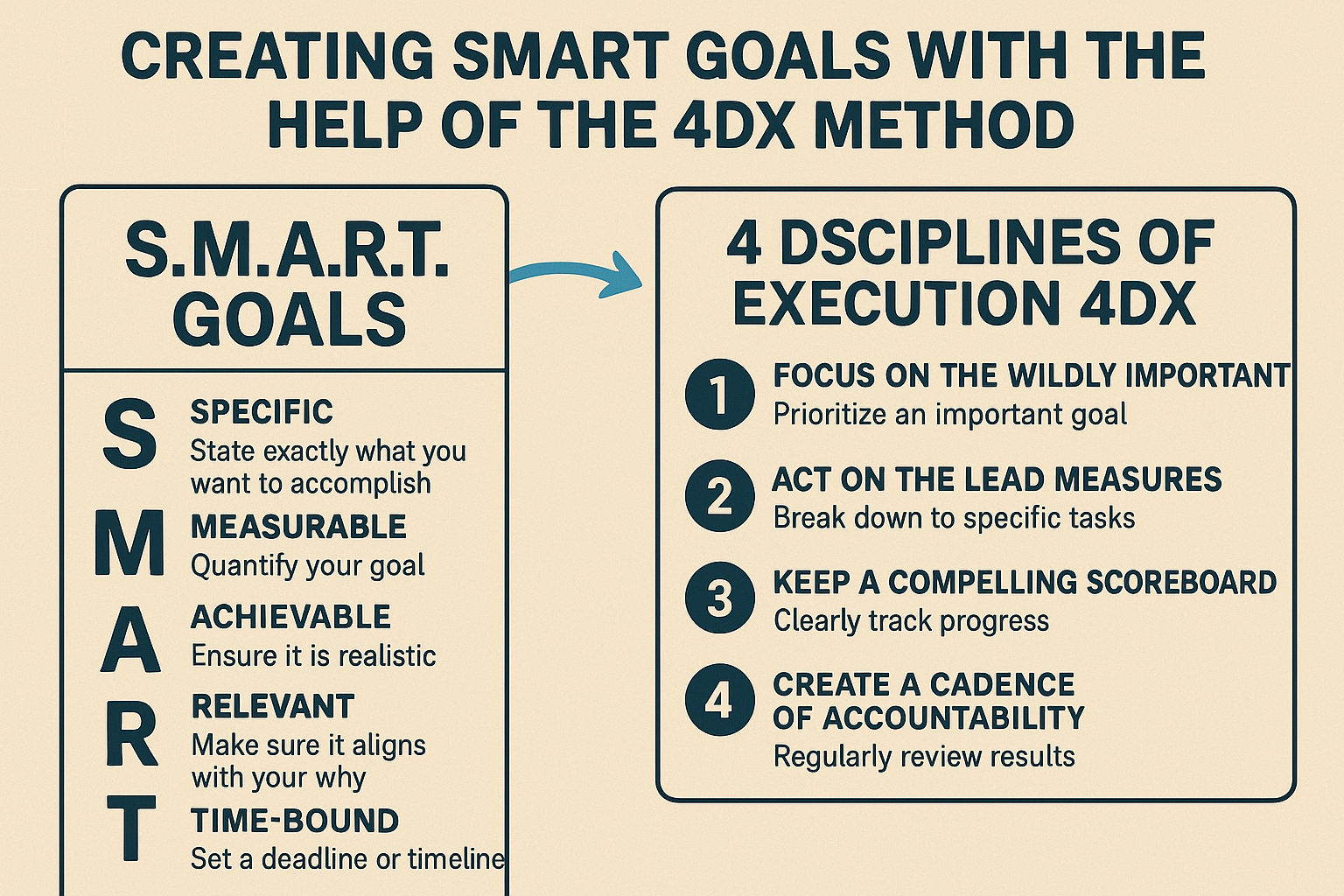Setting goals is easy—achieving them is not. That’s because most goals are too vague or lack structure. SMART goals solve part of that problem by adding clarity, while the 4 Disciplines of Execution (4DX) provide the system to actually follow through.
In this article, you’ll learn how to combine SMART goals with the 4DX framework to define goals more effectively and execute them with consistency.
What Are SMART Goals?
SMART is an acronym that helps you set clear and actionable goals:
- Specific: Clearly defined and focused
- Measurable: Can be tracked with numbers or milestones
- Achievable: Realistic, not just aspirational
- Relevant: Connected to a meaningful purpose
- Time-bound: Has a deadline
Example of a vague goal: “I want to get healthier”
SMART version: “Lose 5kg in 8 weeks by working out 3x per week and tracking meals daily”
Why SMART Goals Alone Aren’t Enough
SMART goals give you a strong foundation—but they don’t include a system for:
- Prioritizing amid daily distractions
- Identifying daily actions that lead to success
- Tracking your performance visually
- Holding yourself accountable
That’s where 4DX comes in. It turns a SMART goal into a consistent execution strategy.
Step 1: Turn Your SMART Goal Into a WIG
The first discipline in 4DX is to focus on a Wildly Important Goal (WIG)—which should already be SMART.
Example:
SMART Goal: “Increase monthly blog traffic from 5,000 to 10,000 in 3 months”
→ This becomes your WIG in 4DX.
Tips:
- Write your WIG at the top of your planner, wall board, or dashboard
- Remind yourself of it daily
- Ensure your team (if applicable) is aligned on it too
Step 2: Define Lead Measures Based on Your SMART Goal
SMART goals give you the destination. Lead measures in 4DX show you the path to get there.
Lead measures should be:
- Predictive of goal achievement
- Influenceable by daily or weekly effort
Example:
- WIG: “Increase blog traffic from 5K to 10K”
- Lead measures: Write 2 SEO articles per week, share each on 3 platforms
Avoid vague tasks: Instead of “Work on content,” schedule “Write 1,000 words for article X.”
Step 3: Build a Scoreboard for Motivation and Tracking
With a SMART WIG and lead measures in place, you need a scoreboard to visualize progress.
What to include:
- Progress bar from current to target metric
- Weekly lead measure tracker
- Space for notes or reflections
Use tools like:
- Google Sheets
- Trello cards
- A whiteboard or printed tracker on your desk
Seeing visible progress reinforces commitment.
Step 4: Add Accountability With Weekly Review
SMART goals don’t typically include a built-in review process. 4DX fixes that with weekly accountability sessions.
Even if you’re working solo, do this:
- Every week, ask:
- Did I hit my lead measures?
- What challenges came up?
- What’s my focus this week?
- If you’re in a team:
- Meet for 15–30 minutes weekly to report progress and set new commitments
This rhythm turns your goal from a static wish into a living process.
Real-Life Example: Applying SMART + 4DX Together
SMART Goal: “Save $3,000 for vacation in 6 months”
WIG (4DX): “From $0 to $3,000 by December 15”
Lead Measures:
- Skip eating out 3x per week
- Transfer $125 every Friday into savings
Scoreboard: - Chart with savings progress + weekly actions
Accountability: - Sunday night review in planner
By combining a clear goal with execution structure, success becomes much more likely.
Final Thought: Clarity + Discipline = Results
SMART goals provide clarity. The 4DX method provides discipline. Together, they help you define what you want and consistently act to achieve it.
If you’ve struggled to follow through on your goals in the past, try this two-step system:
- Make your goal SMART
- Apply the 4 Disciplines to execute it
With a clear target, daily action, visible tracking, and consistent review—you’ll stop setting goals and start achieving them.
